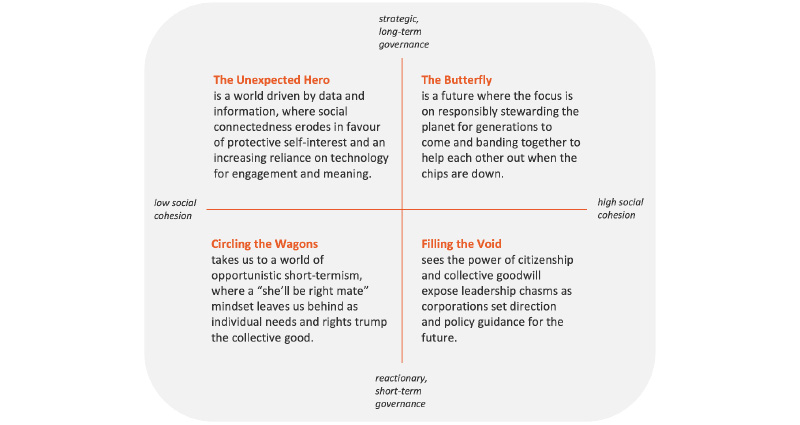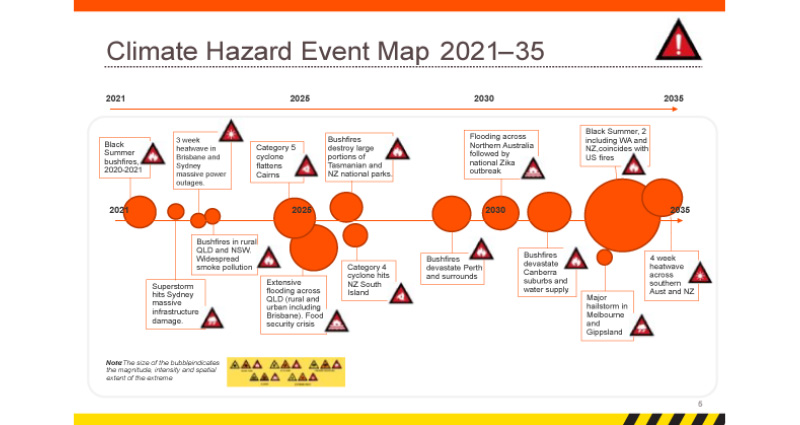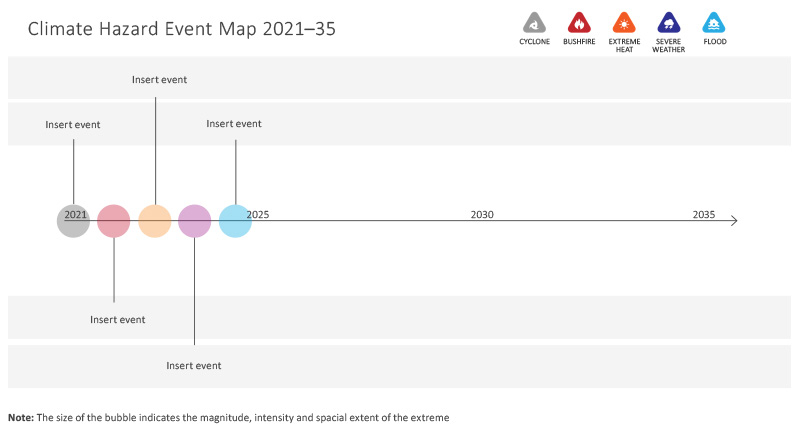Abstract
AFAC convenes an ongoing national Climate Change Group comprised of individuals from jurisdictional emergency management agencies, the Bureau of Meteorology and leading research centres. The group is tasked with producing a body of work to strategically support effective climate change risk mitigation and planning and adaptation outcomes for AFAC members, their stakeholders and the community. In 2020–21, the group received Tactical Research Funding through the Bush Fire and Natural hazards CRC (BNHCRC) to develop a suite of climate and social change scenario resources. These resources can be used by emergency service agencies across Australia and New Zealand to test their strategic planning, preparedness activities and capabilities in an increasingly volatile, uncertain and climate-challenged world. This paper outlines the process used to develop the scenarios and the resources as well as a case study outlining how the transformative scenario methodology was applied by the Queensland Fire and Emergency Services (QFES) to test Queensland’s Strategy 2030.
Developing scenarios
A research team from RMIT University and Reos Partners guided the group through immersive workshops to prduce a set of plausible scenarios about how the future might unfold in a climate-challenged world and what this means for strategic planning and operations in the emergency services sector. The scenario timeframe was set to 2035, which is a period long enough that significant change can take place but close enough to be meaningful and tangible.
Workshop participants were asked to step outside the comfort zone of their organisation and sector to consider other driving forces that shape the world and drill these down to the most significant yet uncertain forces that affect emergency services’s ability to operate effectively. A broad range of driving forces (that can also be understood as uncertainties) were identified, including socio-economic factors, domestic and geopolitical dynamics, the state of the environment, advances in technology, approaches to governance and the level of social cohesion in society. Unlike the relative uncertainty of these driving forces, climate change was locked in as a certainty. That is, we know through scientific consensus that no matter what we do now to avert climate changes, we are on a fixed trajectory of changing weather and climate. In the scenario timeframe to 2035 there will be a continuation of existing climate trends alongside increasing volatility, frequency and magnitude of weather extremes.
Two factors were called out as having the most tangible impact on emergency services ability to operate effectively into the future, namely: the degree to which governance regimes are long-term, proactive and strategic versus short-term and responsive; and the level of social cohesion in society, for example, whether social bonds and collective efforts are strong versus an individualistic ‘me first’ ethos. These factors were mapped against each other on axes to establish the structural framework for 4 distinct and plausible future scenarios. Each scenario, outlined in Figure 1, was developed as a believable narrative to stretch the thinking and mental models of emergency services leaders and to generate new insights and operational improvements. The criteria underpinning each scenario is relevance, plausibility, challenge and clarity.
Each scenario unfolds in a different way and leads to a different future that has distinct and profound implications for emergency services agencies as the they navigate operations in a climate-challenged future.

Figure 1: Four possible futures.
Source: Reos Partners
Scenario resources
A set of scenario resources was developed to help emergency services leaders explore and test how well their organisation will be able to deliver services out to 2035 in a climate-challenged world and to stress test their existing adaptation strategies and plans. The resources are presented as ‘board game’ analogy, where the scenarios become the ‘board’ and the resources are the ‘pieces’ organisations can use to test their services and strategies. The resources are presented in 4 stages.
Stage 1: the board
The first 2 resources, an introduction and guide to using the scenarios, explain and compare the scenarios and provide the tools organisations can use to adjust or create scenarios of their own. For example, the guide outlines the ‘wind-tunnelling’ process, which is a simple and effective way for organisations to test and improve decision-making and planning in an uncertain world where the volatility, frequency and magnitude of climate events will challenge the sector.
A set of case studies demonstrate how the transformative-scenario approach can be used. Worked examples of the wind-tunnelling process are outlined using examples from different emergency agencies, including urban operations, rural operations, land management and State Emergency Services.
Stage 2: the hazard piece
A climate hazard map is included as a visualisation tool to help emergency leaders appreciate the range of hazard exposures that may affect their organisation’s operations and services within each scenario. The worked example in Figure 2 shows a timeline of hazards that may play out in the scenario timeframe to 2035. The hazard map can be used to explore the implications of different hazard types and magnitudes as well as the complexity of navigating consecutive, concurrent and compounding hazard events in each scenario.
A blank hazard event map is included so people can develop and test their hazard profiles (Figure 3).

Figure 2: Climate hazard event map 2021–35.

Figure 3: Blank climate hazard event map 2021–35.
Stage 3: the climate risk piece
When emergency leaders have a solid understanding of the scenarios and the range of hazards that are likely to exist, a ‘climate risk’ piece can be applied. A series of climate 'wild cards’ present possible climate or weather projections that emergency leaders can use to stress test their organisation’s services and capabilities beyond the 4 scenarios and hazards. Organisations can also create their own relevant wild card projections.
Stage 4: further resources
The final resource is a systematic review of literature, ‘Implications of Climate Change for Emergency Services Operations’.1 The report provides a comprehensive picture of what climate change effects might influence the emergency management sector and what resources agencies might have to manage them. The report presents the increasing frequency and severity of hazard events as one of the most immediate and visceral consequences of climate change. However, the report indicated that addressing the effects of climate change requires effort and transformative thinking and action across climate, social, demographic and economic trends. The report presents systems thinking as an enabler of good climate change adaptation. For the emergency services sector, this means broadening the understanding of the sector, how it interacts with the systems and driving forces around it and the implications of climate change for it. A sample systems map helps emergency leaders visualise the elements and relationships under a changing climate. The report also explores what adaptive capacity could look like for under the 4 future scenarios.
Applying the scenario resources with QFES
The scenario research has progressed to the utilisation phase and was applied by QFES in a workshop in June 2022 to stress test Queensland’s Strategy 2030.
QFES was an active participant through the development and utilisation of the transformative and climate scenarios resources. With so much upheaval in recent years, including a pandemic, flooding and intense geopolitics with far-ranging implications, QFES decided to test the efficacy of its Strategy 2030 in a climate-challenged world. Strategy 2030 is a long-term strategy that defines and unites QFES through a vision for a preferred future and a set of guiding principles.
One way QFES tested the efficacy of Strategy 2030 was to bring together subject-matter experts who comprise the QFES Climate Change Advisory Group (QCCAG) and apply the transformative scenarios research. The QCCAG is a diverse group of QFES staff with operational and corporate backgrounds. The transformative scenarios material meant the strategy workshop could be completed in approximately 4 hours. That relatively short time was remarkable when considering that this included determining scenarios, understanding what those scenarios meant (so participants could ‘inhabit’ the scenario) then applying the scenarios using the wind-tunnelling approach to discrete aspects of the strategy in a workshop environment.
The 4 scenarios were applied to test Strategy 2030. Because the scenarios were developed through extensive engagement across the emergency services sector in Australia and New Zealand, a high degree of confidence and trust existed that the scenarios were plausible, even if an individual scenario wasn’t exactly how participants might imagine the world beyond 2030. Supporting audio-visual content integrated succinct summaries of the scenarios to ground subsequent application of the scenarios throughout the session. The suite of climate scenario resources provided a method for integrating a plausible and modifiable climate scenario. In Queensland, that meant QFES could tailor the climate scenario input to reflect versions of past events and modify them in line with climate projections with subject matter experts prior to the strategy workshops. This meant the workshop team could be imaginative (because as the sector has learned, a ‘failure of imagination’ can bring things undone).
For QFES, the strategy-testing session was the focus of participants’ time and efforts, not the creation of scenarios. This matters because the participants in strategy sessions are typically the leaders of organisations. Another way to speed up the process, while still getting the iterations to test strategy, was to run the scenarios in parallel. This means that rather than have each participant inhabit each scenario, participants self-selected which scenario resonated the most with their view of the future. Remarkably, a relatively even distribution of workshop participants across the 4 scenarios eventuated, which reflects well on the representativeness of the scenarios.
The workshop provided compelling insights about Strategy 2030 across the scenarios in a fast and engaging way. It is easily adapted to suit the objectives of strategy development and review. This work demonstrates that scenarios provide a powerful tool for engaging and opening the minds of leaders and decision-makers to pay attention to novel, less comfortable and weaker signals of change, and to prepare for discontinuity and surprise in the future.


